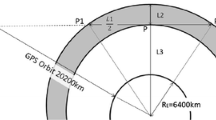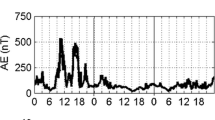Abstract
Amplitude scintillations in Global Navigation Satellite System (GNSS) signals are commonly observed at low latitudes and are frequently associated with equatorial plasma bubbles. The scintillation severity is enhanced around the equatorial ionization anomaly, being controlled, in great part, by the ionospheric F-region background density. This work proposes the use of collocated observations from space-based and distributed ground-based monitors to quantify the relationship between the background F-region peak electron density (NmF2) and scintillation severity. To test the proposed approach and its feasibility, NmF2 observations from the Global-scale Observations of the Limb and Disk (GOLD) instrument and L-band scintillation measurements made by a network of GNSS-based scintillation monitors were used. The observations were made at low latitudes in October 2022, during the ascending phase of solar cycle 25. Results show the influence of background NmF2 on scintillation severity. The results also quantify the control of the latitudinal distribution of maximum S4 values [S4 (max)] by the latitudinal variation of NmF2. An empirical relationship between NmF2 and S4 (max) for a given local time was also derived for the time of GOLD observations. An application of the empirical relationship between NmF2 and maximum S4 is illustrated with regional (Brazilian) maps of potential maximum scintillation severity using GOLD-like data. Encouraging results include showing that S4 (max) can be estimated from independent observations for a distinct longitude sector, but similar solar flux and season. Future studies will address to what extent the relationship between NmF2 and S4 (max) varies for different geophysical conditions.







Similar content being viewed by others
Data availability
The GOLD data is available at the GOLD Science Data Center (https://gold.cs.ucf.edu/data/search/) and at the NASA Space Physics Data Facility (https://spdf.gsfc.nasa.gov/). The IGRF13 used to calculate geomagnetic components is available at https://www.ngdc.noaa.gov/IAGA/vmod/igrf.html. The scintillation data is available at https://ismrquerytool.fct.unesp.br/is/#.
References
Aarons J (1982) Global morphology of ionospheric scintillations. Proc IEEE 70(4):360–378. https://doi.org/10.1109/PROC.1982.12314
Affonso BJ, Moraes AO, Sousasantos J, Marini-Pereira L, Pullen S (2022) Strong ionospheric spatial gradient events induced by signal propagation paths aligned with equatorial plasma bubbles. IEEE Trans Aerosp Electron Syst 58(4):2868–2879. https://doi.org/10.1109/TAES.2022.3144622
Alken P et al (2021) International geomagnetic reference field: the thirteenth generation. Earth, Planets Space 73(49):1–25. https://doi.org/10.1186/s40623-020-01288-x
Basu S, Groves KM (2001) Specification and forecasting of outages on satellite communication and navigation systems. Washington DC Am Geophys Union Geophys Monogr Ser 125:423–430. https://doi.org/10.1029/GM125p0423
Basu S et al (1996) Scintillations, plasma drifts, and neutral winds in the equatorial ionosphere after sunset. J Geophys Res Space Phys 101(A12):26795–26809. https://doi.org/10.1029/96JA00760
Basu S, Basu S, Huba J, Krall J, McDonald SE, Makela JJ, Miller ES, Ray E, Groves K (2009) Day-to-day variability of the equatorial ionization anomaly and scintillations at dusk observed by GUVI and modeling by SAMI3. J Geophys Res Space Phys 114(A4):1–12. https://doi.org/10.1029/2008JA013899
Batista, IS, Diogo EM, Souza JR, Abdu MA, Bailey GJ (2011) Equatorial ionization anomaly: the role of thermospheric winds and the effects of the geomagnetic field secular variation. In: aeronomy of the earth's atmosphere and ionosphere, pp 317–328. Springer, Dordrecht. https://doi.org/10.1007/978-94-007-0326-1_23.
Beyerlein A (2014) Quantile regression: opportunities and challenges from a user’s perspective. Am J Epidemiol 180(3):330–331. https://doi.org/10.1093/aje/kwu178
Briggs BH, Parkin IA (1963) On the variation of radio star and satellite scintillations with zenith angle. J Atmos Terr Phys 25(6):339–366. https://doi.org/10.1016/0021-9169(63)90150-8
Cade BS, Noon BR (2003) A gentle introduction to quantile regression for ecologists. Front Ecol Environ 1(8):412–420. https://doi.org/10.1890/1540-9295(2003)001[0412:AGITQR]2.0.CO;2
Das K, Krzywinski M, Altman N (2019) Quantile regression. Nat Methods 16(6):451–452. https://doi.org/10.1038/s41592-019-0406-y
de Paula ER, Rodrigues FS, Iyer KN, Kantor IJ, Abdu MA, Kintner PM, Ledvina BM, Kil H (2003) Equatorial anomaly effects on GPS scintillations in Brazil. Adv Space Res 31(3):749–754. https://doi.org/10.1016/S0273-1177(03)00048-6
de Paula ER, Monico JFG, Tsuchiya IH, Valladares CE, Costa SMA, Marini-Pereira L, Vani BC, Moraes AO (2023) A retrospective of global navigation satellite system ionospheric irregularities monitoring networks in Brazil. J Aerosp Technol Manag 15(e0123):1–17. https://doi.org/10.1590/jatm.v15.1288
Eastes RW et al (2017) The global-scale observations of the limb and disk (GOLD) mission. Space Sci Rev 212:383–408. https://doi.org/10.1007/s11214-017-0392-2
Eastes RW, Solomon SC, Daniell RE, Anderson DN, Burns AG, England SL, Martinis CR, McClintock WE (2019) Global-scale observations of the equatorial ionization anomaly. Geophys Res Lett 46(16):9318–9326. https://doi.org/10.1029/2019GL084199
Eide E, Showalter MH (1998) The effect of school quality on student performance: a quantile regression approach. Econ Lett 58(3):345–350. https://doi.org/10.1016/S0165-1765(97)00286-3
Flynn CD, McCaffrey AM, Jayachandran PT, Langley RB (2019) Discovery of new code interference phenomenon in GPS observables. GPS Solut 23(65):1–9. https://doi.org/10.1007/s10291-019-0858-7
Forte B, Radicella SM (2002) Problems in data treatment for ionospheric scintillation measurements. Radio Sci 37(6):8-1–8-5. https://doi.org/10.1029/2001RS002508
Hall P, Sheather SJ (1988) On the distribution of a studentized quantile. J Roy Stat Soc: Ser B (methodol) 50(3):381–391. https://doi.org/10.1111/j.2517-6161.1988.tb01735.x
Hesterberg T (2011) Bootstrap. Wiley Interdiscip Rev Comput Stat 3(6):497–526. https://doi.org/10.1002/wics.182
Kelley MC, Larsen MF, La Hoz C (1981) Gravity wave initiation of equatorial spread F: a case study. J Geophys Res 86(A11):9087–9100. https://doi.org/10.1029/JA086iA11p09087
Khadka SM, Valladares CE, Sheehan R, Gerrard AJ (2018) Effects of electric and neutral wind on the asymmetry of equatorial ionization anomaly. Radio Sci 53(5):683–697. https://doi.org/10.1029/2017RS006428
Koenker R (2005) Quantile regression (econometric society monographs). Cambridge University Press, Cambridge. https://doi.org/10.1017/CBO9780511754098
Koenker R, Bassett G Jr (1978) Regression quantiles. Econometrica 46(1):33–50. https://doi.org/10.2307/1913643
Lou S, Jiang X, Scott PJ (2013) Geometric computation theory for morphological filtering on freeform surfaces. Proc R Soc Lond Math Phys Eng Sci 469(2159):20130150. https://doi.org/10.1098/rspa.2013.0150
McClintock WE et al (2020) Global-scale observations of the limb and disk mission implementation: 2. Observations, data pipeline, and level 1 data products. J Geophys Res Space Phys 125(5):1–16. https://doi.org/10.1029/2020JA027809
Monico JFG et al (2022) The GNSS NavAer INCT project overview and main results. J Aerosp Technol Manag 14(e0722):1–23. https://doi.org/10.1590/jatm.v14.1249
Monico JFG, Camargo PO, Alves DBM, Shimabukuro MH, Aquino M, Pereira VAS, Vani BC (2013) From CIGALA to CALIBRA: an infrastructure for ionospheric scintillation monitoring in Brazil. In: AGU meeting of Americas in Cancun.
Moraes AO, Costa E, Abdu MA, Rodrigues FS, de Paula ER, Oliveira K, Perrella WJ (2017) The variability of low-latitude ionospheric amplitude and phase scintillation detected by a triple-frequency GPS receiver. Radio Sci 52(4):439–460. https://doi.org/10.1002/2016RS006165
Moraes AO, Muella MTAH, de Paula ER, Oliveira CBA, Terra WP, Perrella WJ, Meibach-Rosa PRP (2018a) Statistical evaluation of GLONASS amplitude scintillation over low latitudes in the Brazilian territory. Adv Space Res 61(7):1776–1789. https://doi.org/10.1016/j.asr.2017.09.032
Moraes AO et al (2018b) GPS availability and positioning issues when the signal paths are aligned with ionospheric plasma bubbles. GPS Solut 22(4):1–12. https://doi.org/10.1007/s10291-018-0760-8
Moraes AO, Vani BC, Costa E, Sousasantos J, Abdu MA, Rodrigues FS, Gladek YC, de Oliveira CBA, Monico JFG (2018c) Ionospheric scintillation fading coefficients for the GPS L1, L2, and L5 frequencies. Radio Sci 53(9):1165–1174. https://doi.org/10.1029/2018RS006653
Reinisch BW, Bibl K, Kitrosser DF, Sales GS, Tong JS, Zahn ZM, Bullett TW, Rails JA (1989) The Digisonde 256 ionospheric sounder. In: Liu, C. H. (eds.) World ionosphere/thermosphere study. WITS Handbook, vol 2, pp 350–366. SCOSTEP, IL
Rodrigues FS, Socola JG, Moraes AO, Martinis C, Hickey DA (2021) On the properties of and ionospheric conditions associated with a mid-latitude scintillation event observed over southern United States. Space Weather 19(6):1–20. https://doi.org/10.1029/2021SW002744
Salles LA, Moraes AO, Vani BC, Sousasantos J, Affonso BJ, Monico JFG (2021) A deep fading assessment of the modernized L2C and L5 signals for low-latitude regions. GPS Solut 25(122):1–13. https://doi.org/10.1007/s10291-021-01157-4
Smith JM, Heelis RA (2018a) The plasma environment associated with equatorial ionospheric irregularities. J Geophys Res Space Physics 123(2):1583–1592. https://doi.org/10.1002/2017JA024933
Smith JM, Heelis RA (2018b) Plasma dynamics associated with equatorial ionospheric irregularities. Geophys Res Lett 45(16):7927–7932. https://doi.org/10.1029/2018GL078560
Sobral JHA, Abdu MA, Takahashi H, Taylor MJ, de Paula ER, Zamlutti CJ, de Aquino MG, Borba G (2002) Ionospheric plasma bubble climatology over Brazil based on 22 years (1977–1998) of airglow observations. J Atmos Solar Terr Phys 64(12–14):1517–1524. https://doi.org/10.1016/S1364-6826(02)00089-5
Sousasantos J, Moraes AO, Sobral JHA, Muella MTAH, de Paula ER, Paolini RS (2018) Climatology of the scintillation onset over southern Brazil. Ann Geophys 36(2):565–576. https://doi.org/10.5194/angeo-36-565-2018
Sousasantos J, Abdu MA, de Paula ER, Moraes AO, Salles LA, Affonso BJ (2022a) Conjugated asymmetry of the onset and magnitude of GPS scintillation driven by the vertical plasma drift. GPS Solut 26(75):1–13. https://doi.org/10.1007/s10291-022-01258-8
Sousasantos J, Affonso BJ, Moraes AO, Rodrigues FS, Abdu MA, Salles LA, Vani BC (2022b) Amplitude scintillation severity and fading profiles under alignment between GPS propagation paths and equatorial plasma bubbles. Space Weather 20(11):1–15. https://doi.org/10.1029/2022SW003243
Sousasantos J, Gomez Socola J, Rodrigues FS, Eastes RW, Brum CGM, Terra P (2023) Severe L-band scintillation over low-to-mid latitudes caused by an extreme equatorial plasma bubble: joint observations from ground-based monitors and GOLD. Earths Planets Space 75(41):1–12. https://doi.org/10.1186/s40623-023-01797-5
Sternberg SR (1983) Biomedial image processing. Computer 16(1):22–34. https://doi.org/10.1109/MC.1983.1654163
Vani BC, Forte B, Monico JFG, Skone S, Shimabukuro MH, Moraes AO, Portella IP, Marques HA (2019) A novel approach to improve GNSS precise point positioning during strong ionospheric scintillation: theory and demonstration. IEEE Trans Veh Technol 68(5):4391–4403. https://doi.org/10.1109/TVT.2019.2903988
Vani BC, Moraes AO, Salles LA, Breder, VHF, Freitas MJS, Monico JFG, de Paula ER (2021) Monitoring ionospheric scintillations with GNSS in South America: Scope, results, and challenges. In: GPS and GNSS technology in geosciences, pp 255–280, Elsevier. https://doi.org/10.1016/B978-0-12-818617-6.00012-3.
Wei Y, Pere A, Koenker R, He X (2006) Quantile regression methods for reference growth charts. Stat Med 25(8):1369–1382. https://doi.org/10.1002/sim.2271
Whalen JA (2009) The linear dependence of GHz scintillation on electron density observed in the equatorial anomaly. Ann Geophys 27(4):1755–1761. https://doi.org/10.5194/angeo-27-1755-2009
Yeh KC, Liu CH (1982) Radio wave scintillations in the ionosphere. Proc IEEE 70(4):324–360. https://doi.org/10.1109/PROC.1982.12313
Yousuf M, Dashora N, Sridhar M, Dutta G (2023) Long-term impact of ionospheric scintillations on kinematic precise point positioning: seasonal and solar activity dependence over Indian low latitudes. GPS Solut 27(40):1–12. https://doi.org/10.1007/s10291-022-01378-1
Acknowledgements
Research at UT Dallas was supported by NSF awards AGS-1916055 and AGS-2122639. A. O. Moraes is grateful to CNPq (309389/2021-6). R. W. Eastes was supported by NASA contract 80GSFC18C0061 to the University of Colorado. J. F. G. Monico acknowledges CNPq (304773/2021-2). Authors would like to thank the International Association of Geomagnetism and Aeronomy (IAGA) and all the scientific and technical staff responsible for the distribution of the International Geomagnetic Reference Field (IGRF). Projects CIGALA/CALIBRA were funded by the European Commission (EC) in the framework of awards FP7-GALILEO-2009-GSA and FP7–GALILEO–2011–GSA–1a, as well of FAPESP award 06/04008-2. INCT NavAer is supported by CNPq (465648/2014-2) and FAPESP (2017/50115-0). GOLD is supported by NASA contract 80GSFC18C0061 to the University of Colorado.
Author information
Authors and Affiliations
Contributions
JSS contributed with processing of the observations, writing of the manuscript, figures, and interpretation of the results. FSR proposed the study and contributed with interpretation of the results and writing of the manuscript. AOM contributed with processing, interpretation of scintillation data and writing of the manuscript. RWE curated the GOLD data and contributed with the writing of the manuscript. JFGM curated the scintillation data and writing of the manuscript. All authors reviewed the manuscript.
Corresponding author
Ethics declarations
Competing interests
The authors declare no competing interests.
Additional information
Publisher's Note
Springer Nature remains neutral with regard to jurisdictional claims in published maps and institutional affiliations.
Supplementary Information
Below is the link to the electronic supplementary material.
Rights and permissions
Springer Nature or its licensor (e.g. a society or other partner) holds exclusive rights to this article under a publishing agreement with the author(s) or other rightsholder(s); author self-archiving of the accepted manuscript version of this article is solely governed by the terms of such publishing agreement and applicable law.
About this article
Cite this article
Sousasantos, J., Rodrigues, F.S., Moraes, A.O. et al. On the estimation of scintillation severity using background F-region peak densities: description and example results using GOLD observations. GPS Solut 28, 62 (2024). https://doi.org/10.1007/s10291-023-01602-6
Received:
Accepted:
Published:
DOI: https://doi.org/10.1007/s10291-023-01602-6




